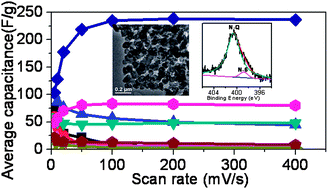Nitrogen-containing microporous carbon nanospheres with improved capacitive properties†
Abstract
We report the largely improved electrochemical capacitance of

- This article is part of the themed collection: Carbon nanostructures
* Corresponding authors
a
State Key Laboratory of Multiphase Complex Systems, Institute of Process Engineering, Chinese Academy of Sciences, Beijing, China
E-mail:
fbsu@mail.ipe.ac.cn
b Institute of Chemical Engineering and Sciences, 1 Pesek Road, Jurong Island, Singapore
c
School of Chemical and Biomedical Engineering, Nanyang Technological University, 70 Nanyang Drive, Singapore, Singapore
E-mail:
xwlou@ntu.edu.sg
d Department of Chemical Engineering, Curtin University of Technology, GPO Box U1987, Bentley, Perth, Western Australia, Australia
We report the largely improved electrochemical capacitance of

 Please wait while we load your content...
Something went wrong. Try again?
Please wait while we load your content...
Something went wrong. Try again?
F. Su, C. K. Poh, J. S. Chen, G. Xu, D. Wang, Q. Li, J. Lin and X. W. Lou, Energy Environ. Sci., 2011, 4, 717 DOI: 10.1039/C0EE00277A
To request permission to reproduce material from this article, please go to the Copyright Clearance Center request page.
If you are an author contributing to an RSC publication, you do not need to request permission provided correct acknowledgement is given.
If you are the author of this article, you do not need to request permission to reproduce figures and diagrams provided correct acknowledgement is given. If you want to reproduce the whole article in a third-party publication (excluding your thesis/dissertation for which permission is not required) please go to the Copyright Clearance Center request page.
Read more about how to correctly acknowledge RSC content.
 Fetching data from CrossRef.
Fetching data from CrossRef.
This may take some time to load.
Loading related content
